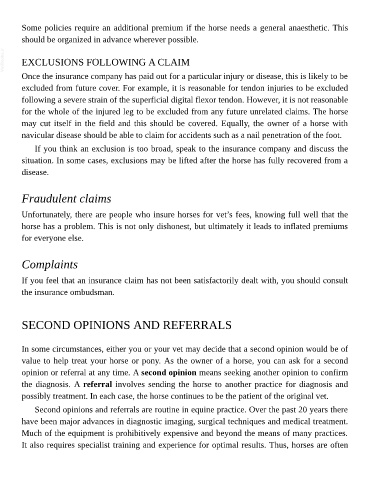Page 1111 - The Veterinary Care of the Horse
P. 1111
Some policies require an additional premium if the horse needs a general anaesthetic. This
should be organized in advance wherever possible.
VetBooks.ir EXCLUSIONS FOLLOWING A CLAIM
Once the insurance company has paid out for a particular injury or disease, this is likely to be
excluded from future cover. For example, it is reasonable for tendon injuries to be excluded
following a severe strain of the superficial digital flexor tendon. However, it is not reasonable
for the whole of the injured leg to be excluded from any future unrelated claims. The horse
may cut itself in the field and this should be covered. Equally, the owner of a horse with
navicular disease should be able to claim for accidents such as a nail penetration of the foot.
If you think an exclusion is too broad, speak to the insurance company and discuss the
situation. In some cases, exclusions may be lifted after the horse has fully recovered from a
disease.
Fraudulent claims
Unfortunately, there are people who insure horses for vet’s fees, knowing full well that the
horse has a problem. This is not only dishonest, but ultimately it leads to inflated premiums
for everyone else.
Complaints
If you feel that an insurance claim has not been satisfactorily dealt with, you should consult
the insurance ombudsman.
SECOND OPINIONS AND REFERRALS
In some circumstances, either you or your vet may decide that a second opinion would be of
value to help treat your horse or pony. As the owner of a horse, you can ask for a second
opinion or referral at any time. A second opinion means seeking another opinion to confirm
the diagnosis. A referral involves sending the horse to another practice for diagnosis and
possibly treatment. In each case, the horse continues to be the patient of the original vet.
Second opinions and referrals are routine in equine practice. Over the past 20 years there
have been major advances in diagnostic imaging, surgical techniques and medical treatment.
Much of the equipment is prohibitively expensive and beyond the means of many practices.
It also requires specialist training and experience for optimal results. Thus, horses are often

